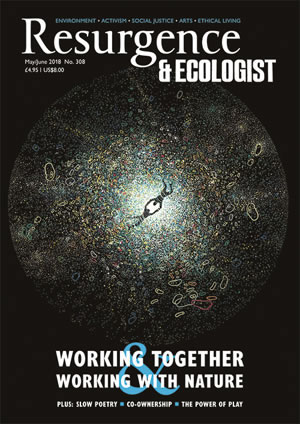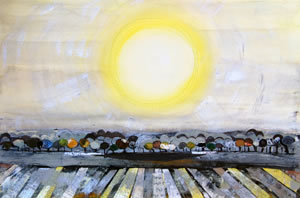Are you hopeful about the future? How do you feel about the state of the world? About two years ago, I posed these questions to my family, friends and colleagues. The responses I received were alarming. Not one person said they felt hopeful and many spoke about their fear, sadness, despair, anger, guilt and/or grief. Having worked on ecological issues professionally for almost 40 years, I am very familiar with these emotions, but I was shocked by how common they were among the people I know.
This completely unscientific survey was part of a personal enquiry into hope that I started back in 2011. One day, when I was feeling especially disheartened about the Fukushima nuclear power station disaster in Japan, I found myself asking myself questions such as, “How can I be hopeful when the world seems to be falling apart?”, “How can I nurture hope?” and, “What does hope even mean in these times?” And because I had no satisfactory answers, I decided to launch an investigation into the subject.
The first step was to look in the dictionary. Most common definitions use words like ‘desire’, ‘expectation’ and ‘anticipation’. The Concise Oxford English Dictionary says that hope is “expectation and desire combined” and Merriam-Webster’s says it is “to cherish a desire with anticipation”. After reflecting on these definitions, I realised they are based on the assumption that life should give us whatever we desire. In other words, whenever we hope for something, there’s a belief – even if it is very subtle – that events will conform with our wishes.
But life doesn’t always give us what we want. Many people, including me, hope to see a just, peaceful and sustainable society. But as global ecological problems continue to worsen, life seems to be giving us the opposite – what we don’t want. The trend lines for climate disruption, water scarcity, species extinction and resource depletion say it all. No matter how sincere and well-intentioned our hopes and no matter how hard we work to achieve them, there are no guarantees we will get what we want.
There is, therefore, a dissonance between our hopes for the future and what is actually happening. This makes it inevitable that we will experience fear, sadness, despair, anger, guilt and grief. Indeed, the yawning gap between what we hope for and the reality of life is a set-up for these painful feelings. Even though our hopes may be noble and altruistic, the more desperately we want to attain them the more emotional suffering we will experience when life doesn’t conform with our wishes.
By this stage of my enquiry, I was feeling even worse than when I started. So I went back to the dictionary, and thankfully I found another definition. In addition to defining hope in terms of desire, expectation and anticipation, most dictionaries provide secondary, archaic definitions of it as ‘trust’. This older and much less common meaning is based on having confidence in life, without the expectation or anticipation that we will get what we want any time soon. To me, this type of hope feels much more robust and capacious than the first type because it doesn’t depend on attaining specific improvements in life. At last I felt that I was finding answers to my questions.
Related to Judaeo-Christian hope, this type of hope has an unshakeable faith in whatever happens and in the human capacity to respond. It is an outlook or an inclination towards life that is positive, although not necessarily optimistic. Unlike the first type of hope, which is based on expecting or anticipating favourable outcomes in our external circumstances and conditions, the second type comes from inside – from our hearts, souls and spirits. It is about loving life so much that we cannot sit idly by and do nothing. I called this type of hope ‘intrinsic hope’ and I called the first type ‘extrinsic hope’. Václav Havel described intrinsic hope, saying: “[Hope is] a state of mind, not a state of the world … it is a dimension of the soul; it’s not essentially dependent on some particular observation of the world or estimate of the situation. Hope is not prognostication. It is an orientation of the spirit, an orientation of the heart; it transcends the world that is immediately experienced, and is anchored somewhere beyond its horizons.”
Over time, I came to see that intrinsic hope is inherent in all life. Where there is life, there is hope. We can experience hope simply because we are alive. It is sewn into our genes – just as it is sewn into the genes of every living thing. It’s the way a dandelion sprouts between the cracks in a city pavement, even if there’s no soil, lots of pollution and a constant onslaught of passing pedestrians and dogs. It’s the way a single maple tree releases hundreds of thousands of seeds, oblivious of whether any take root and grow. And it’s the way Pacific salmon, heavy with eggs, strain to swim up their natal rivers and streams to spawn, even though they will die in the effort. One could say that intrinsic hope is life’s love for itself.
Although we are all born with intrinsic hope, it’s easy to forget. Because we usually focus on problems and difficulties, we can fail to appreciate the miracle of life and become blind to its potentials and possibilities. By concentrating on the negative, we don’t see the positive. By emphasising what we lack and what we want, we ignore what we already have, and don’t consider what could be.
I’m not suggesting that we become like Pollyanna and adopt a naively optimistic outlook on life. Intrinsic hope is not about wishful thinking. However, it offers a different and helpful perspective on what’s happening. Moreover, we can choose to embrace intrinsic hope at any time, no matter how bad things seem. Victor Frankl, who survived the Nazi concentration camps in the second world war, said, “Everything can be taken from a man but one thing: the last of the human freedoms – to choose one’s attitude in any given set of circumstances, to choose one’s own way.”
So can we choose intrinsic hope in these troubled times? Can we choose to come from love rather than fear? Can we choose to come from compassion rather than anger? Can we stay open and engaged rather than closing down or distancing ourselves from those we disagree with? Can we let go of wanting to achieve particular goals and immerse ourselves in doing what is good and right, simply for its own sake?
This is a tall order and it is one I still struggle with. So, to conclude my investigation, I decided to explore how I could sustain and nourish intrinsic hope in daily life. And after careful reflection, I identified six ‘habits of hope’ – being present, expressing gratitude, loving the world, accepting what is, taking action, and persevering for the long haul – and I sincerely ‘hope’ that these simple ways of being are as helpful to you as they are to me.
Sustaining intrinsic hope is not always easy, but it is essential. If we lose hope and give up, all the gloomy predictions about the future will likely become a reality. And if we dwell on our extrinsic hopes, we will continue to feel fear, sadness, despair, anger, guilt and grief whenever life does not give us what we want. But if we can live from intrinsic hope, we will be able to cope with whatever happens – staying positive and engaged even in the darkest of times. And in doing so, we can influence whether there will be a viable future for our children, their children and all future generations of life on Earth.
HABITS OF HOPE
Being present cultivates intrinsic hope as it increases our awareness of life. Although our bodies are always in the present, our minds are usually wandering somewhere else. When we are present, our minds slow down, life reveals itself and this makes it possible for us to respond to what’s happening in a fresh, unobstructed and positive way.
Expressing gratitude fosters intrinsic hope. When we are grateful, we naturally become more hopeful. It’s what gets poured into the glass to make it half full. It’s counting our blessings, not only our problems.
Loving the world nurtures intrinsic hope because when we feel love for others, or experience others’ love for us, we naturally feel good. We can love other people whether we know them or not, we can love specific communities and places, and we can love the Earth itself.
Accepting the reality of our situation lays a foundation for hope because it gives us the possibility of changing things. By saying yes – even a qualified or reluctant yes – we accept responsibility for doing something about our problems.
Taking action develops hope as it liberates us from the vicious cycle of not wanting to do anything because we feel hopeless and then feeling hopeless because we are not doing enough.
Persevering for the long haul is essential for intrinsic hope because it provides the determination to endure whatever happens and keep on going. With perseverance, we can work to resolve our problems and build a just, peaceful and sustainable world without expecting to see the fruits of our efforts.








